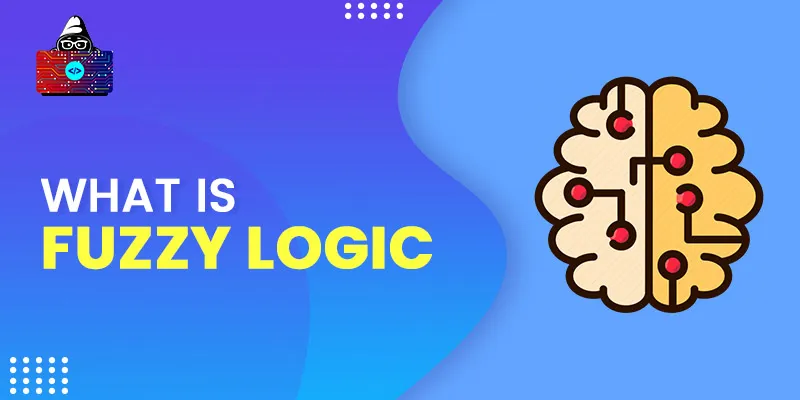You might have heard the term fuzzy logic. The term fuzzy means not clear or vague. Humans are more intelligent than computers and can make use of reasoning to tackle vague situations.
For example, consider that the weather is neither too cold nor less cold, and is something between them both. Therefore, humans can tell what exactly the weather is, like too cold, a little cold, cannot determine, or less cold.
But for this situation, computers with a conventional logic block can either generate too cold or less cold as their output. They do not know intermediate possibilities. To overcome this limitation, we can use fuzzy logic. It offers flexibility for reasoning. More precisely, it is a reasoning approach that resembles human reasoning.
This article will help you understand what fuzzy logic is, its key characteristics, and why we need it. Later, we will make discuss its architecture, the membership function, and the difference between classical and fuzzy sets. Finally, this article will discuss the applications and the pros and cons of fuzzy logic.
So, without further ado, let us get started.
What is Fuzzy Logic?
Fuzzy logic is a form of many-valued logic that works similarly to the way humans think and make decisions. It is a computing technique that considers all possible intermediate values between Yes and No, like Certainly Yes, Possibly Yes, Cannot Determine, Possibly No, and Certainly No.
Unlike the boolean logic , which only works on only two inputs, fuzzy logic considers multiple input values, ranging between two boolean values, 0 and 1, and produces a definite and acceptable output. In the boolean logic, 1 denotes absolute true, whereas 0 denotes absolute false.
Lofti Zadeh, in 1965, introduced the term based on the fuzzy set theory. He found that conventional computer logic was not able to handle data that represents subjective human ideas. Therefore, he introduced fuzzy logic, enabling computers or systems that can take such human ideas.
To understand more about fuzzy logic, let us look at a simple example. Consider that a system has to produce an output for the sentence, ‘Is it hot water?’
The boolean logic involves only two inputs: Yes/1 or No/0. On the other hand, fuzzy logic involves three input values: Very Much/0.9, Little/0.25, and Very Less/0.1.
Therefore, fuzzy logic considers all the available data before coming to a conclusion for any problem and makes the best possible decision. Its implementation is supported in large network-based systems, microcontrollers, and workstation-based systems. Moreover, you can implement this type of many-valued logic in hardware, software, or a combination of the two.
Features of Fuzzy Logic
- It helps imitate the human thinking process to generate the best possible output from the available input values.
- It is the most suitable approach to determine a solution to issues that involve contradictory and uncertain conditions.
- Fuzzy logic is easy to comprehend and implement.
- It supports developing non-linear functions of arbitrary complexities.
- Data analysts use it to improve an algorithm’s execution.
Why use Fuzzy Logic?
- It assists us in dealing with the uncertain and contradictory conditions in engineering.
- Though it does not provide accurate reasoning, it offers acceptable and relevant reasoning.
- Fuzzy logic controls machines and consumer products.
The Fuzzy Logic System Architecture
A fuzzy logic system has four components, namely Rule Base, Fuzzification Module, Inference Engine, and Defuzzification. Let's know about each of them one by one:
1. Rule Base
Experts define rules and if-then conditions to implement fuzzy logic in systems. Rule base stores all these rules and the if-then conditions.
2. Fuzzification Module
This component transforms system inputs, i.e., crisp numbers, into fuzzy sets. The Fuzzification Module divides an input signal into the following five different states:
- LP : X is a Large Positive.
- MP : X is a Medium Positive.
- S : X is Small.
- MN : X is a Medium Negative.
- LN : X is a Large Negative.
3. Inference Engine
The inference engine is responsible for determining the degree of match between rules defined by experts and the current fuzzy input. Depending upon the matching degree, the system determines the rule to be implemented according to the given fuzzy input value. Later, it develops control actions, which is a combination of all the implemented or applied rules.
4. Defuzzification
Finally, the defuzzification process transforms fuzzy sets into crisp numbers, which are acceptable by users. Numerous techniques for converting fuzzy sets into crisp numbers are available. Therefore, it is important to choose the best suitable technique.
Membership Function
The membership function enables us to represent a fuzzy set in terms of a graph. It is also referred to as an indicator or characteristic function. For every element present in the fuzzy set, its value is mapped to the value ranging between 0 and 1. For the fuzzy set A, the membership function for X is: ?A: X ? [0,1]. Every element of the set X is mapped to a value between 0 and 1. It is known as membership value or a degree of membership.
Classical Set vs. Fuzzy Set Theory
The following table enumerates the major differences between a classical set or a crisp set and a fuzzy set.
| Classical Set | Fuzzy Set |
| A classical set is a set consisting of distinct objects. For example, a set of days in a week, months in a year, and colors in a rainbow. | A fuzzy set is a set consisting of degrees of membership between 0 and 1. A set of young people and all real numbers between 0 and 1 are examples of fuzzy sets. |
| Classical sets have precise and certain boundaries. | Fuzzy sets have vague or ambiguous boundaries. |
| An individual entity in a classical set is referred to as an element or a member of that set. Any element is either a member of a set or not, and it does not support partial membership. | When a member of one fuzzy set is also the part of another fuzzy set, then the partial membership exists. |
| Classical sets are based on bi-valued logic. | Fuzzy sets are based on infinite-valued logic. |
| These sets find extensive use in designing digital systems. | It is used in fuzzy controllers. |
Applications of Fuzzy Logic
- The aerospace industry uses fuzzy logic to control the altitude of satellites and spacecrafts.
- In automotive systems, it helps in controlling speed and traffic.
- Large organizations use it for personal evaluation and decision-making support systems.
- Fuzzy logic helps in managing the distillation process and controlling the ph in chemical industries.
- It is widely used in artificial intelligence applications and natural language processing (NLP).
- Smart air conditioners, humidifiers, and heaters also make use of it.
- In the finance sector, it helps to predict the movement of the stock market and thus, helps in managing the funds.
Pros and Cons of Fuzzy Logic
Pros
- Algorithms in fuzzy logic can be described using fewer data, which does not require large memory.
- Its structure is so simple that anyone can understand it quickly.
- Numerous sectors use it to provide effective solutions to complex problems.
- The fuzzy logic system supports noisy, distorted, and imprecise input data.
- Anyone can add or delete rules defined in this type of many-valued logic. Hence, it is more flexible.
- Though it does not require precise inputs, it produces acceptable and definite results.
Cons
- It is ideal for only those problems that do not require accurate results.
- It cannot identify neural network types and machine learning patterns.
- The fuzzy logic system takes a long time to generate outputs.
- Fuzzy logic systems are entirely dependent on human expertise and knowledge.
- Setting precise membership functions and fuzzy rules are challenging tasks.
- Verification and validation of fuzzy logic systems require a lot of testing.
Conclusion
Fuzzy logic is a form of many-valued logic that helps systems or machines to think similarly to humans and make decisions accordingly. It has wide applications in numerous industries. It is also one of the easiest machine learning techniques. However, designing a fuzzy logic system requires guidance from experts a solid understanding of how it works.
We hope that this article will help you better understand the term and its various aspects. Feel free to share your views and opinions regarding this article via the dedicated comments section below!
People are also reading:
- What is Data Wrangling?
- Data Science vs Data Mining
- Best Data Science Bootcamps
- Data Science Lifecycle
- Best Data Science Certifications
- Data Science Process
- Big Data Frameworks for Data Science
- Data Science Career Opportunities
- Data Science Applications in Finance
- Top Data Science Programming Languages





Leave a Comment on this Post